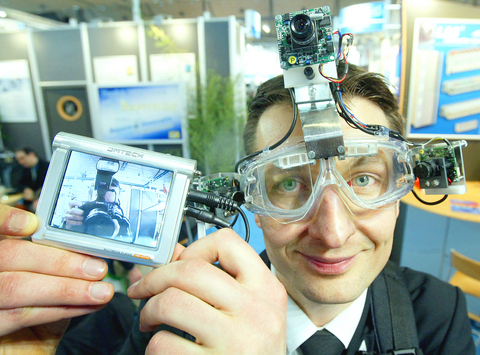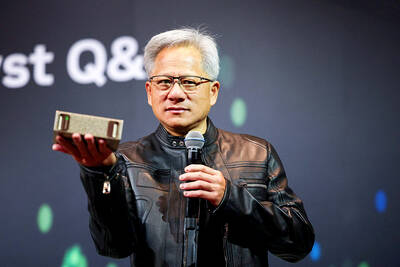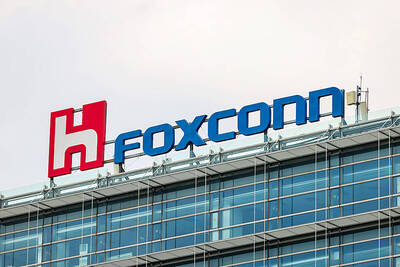More is better at CeBIT, but not in terms of size. And when it comes to gadgets for technology-crazy consumers, there is no limit -- in idea or price.
Samsung Corp is aiming right at the luxury market with one of its new MP3 players, one that practically guarantees it won't be mistakenly left behind at a restaurant.
After all, the pocket-watch like player is encrusted with diamond studs. Twelve of them.

PHOTO: AFP
Besides the diamonds, the player features between 128 megabytes and one gigabyte of memory, as well as an FM radio. The company didn't say how many it hoped to sell, but it will cost less than US$1,000.
For the not so well-heeled, the South Korean electronics giant showcased its line of new camera phones. All are palm-sized, easy to use and some have cameras with resolutions of at least 5 megapixels. The SCHV770 has a seven-megapixel camera with an optical zoom lens that can be attached when a great photo opportunity arises.
CeBIT, the world's largest technology fair, is the chance for companies to talk about their future plans and showcase products that, while not on the market yet, are coming in the future.
It's a chance for the industry, and the estimated half a million people who will visit the fair before it ends on Wednesday, to see how technology can improve their lifestyles.
Take, for instance, navigation software maker TomTom. It's taking GPS software, already showing up on most automakers' list of options, and putting it in motorcycles and mopeds.
Dubbed the TomTom RIDER, the software and hardware comes ready to be installed on most motorcycles or scooters, giving their riders help in finding their way around, if not another reason not to look at the road.
"TomTom RIDER will redefine what it is like for scooter riders or bikers to easily find their way in any urban jungle or explore any open road in Europe," said Harold Goddijn, the Dutch company's chief executive. "Just fix the case on your motorcycle or scooter, turn it on and go."
It also comes with a Bluetooth headset, meaning a driver's hands stay on the handlebars, not the phone.
Plug-and-play by design, the device sports a touchscreen that works with leather gloves, as well as anti-glare screen and sun visor to keep visibility easy. It comes preinstalled with feature-rich maps, and a voice (available in 30 languages) provides turn-by-turn instructions through the headset.
Other companies were bringing new security methods to display and sell, such as the "palm vein" scanner exhibited by Japan's Fujitsu Ltd.
Using infrared light, the device, about the size of a pack of cigarettes, scans the palm of a person's hand. In doing so, it checks the person's vein patterns -- and if they match those on file, can open a door or give them access to a computer.
"In the future it will be possible for a bank's customers to withdraw funds from cashpoints with a single hand gesture," the company said of the device, which doesn't require any contact with the hand.
And for PDA users looking for something more than a stylus to input data, the UK's Eleksen was showing off a wireless fabric keyboard that can be folded or rolled up and put inside a pocket.
The keyboard, dubbed the Texter, is made from material embedded with sensor wires, and is designed for use with mobiles and PDAs. If it gets dirty, it can be wiped down with a wet rag to clean it.
Sony Ericsson, the joint venture between LM Ericsson and Sony Corp, launched a mobile camera, sort of, dubbed the ROB-1.
Sporting a small camera, the sphere-like device moves about on three wheels, steered via a Bluetooth connection to a cell phone up to 50m away. Its onboard camera can pivot upward by 70 degrees or down by 20 degrees. Snap a picture and it's stored in the device's onboard memory or sent to your phone.
"This is a great gadget for people who really like testing the latest technology firsthand and having fun with new applications," said Ulf Persson, corporate vice president and head of accessories for the company. "Just like the Sony Ericsson Bluetooth Car which appealed to a wide range of gadget fans, we believe that ROB-1 will become the `must have' Bluetooth gadget to show off to friends and family."
The device is 11cm in diameter and can move forward, backward and around corners. Its camera can transmit live images back to the phone controlling it. It's expected to go on sale by the fall, but a price wasn't disclosed.

SEEKING CLARITY: Washington should not adopt measures that create uncertainties for ‘existing semiconductor investments,’ TSMC said referring to its US$165 billion in the US Taiwan Semiconductor Manufacturing Co (TSMC, 台積電) told the US that any future tariffs on Taiwanese semiconductors could reduce demand for chips and derail its pledge to increase its investment in Arizona. “New import restrictions could jeopardize current US leadership in the competitive technology industry and create uncertainties for many committed semiconductor capital projects in the US, including TSMC Arizona’s significant investment plan in Phoenix,” the chipmaker wrote in a letter to the US Department of Commerce. TSMC issued the warning in response to a solicitation for comments by the department on a possible tariff on semiconductor imports by US President Donald Trump’s

‘FAILED EXPORT CONTROLS’: Jensen Huang said that Washington should maximize the speed of AI diffusion, because not doing so would give competitors an advantage Nvidia Corp cofounder and chief executive officer Jensen Huang (黃仁勳) yesterday criticized the US government’s restrictions on exports of artificial intelligence (AI) chips to China, saying that the policy was a failure and would only spur China to accelerate AI development. The export controls gave China the spirit, motivation and government support to accelerate AI development, Huang told reporters at the Computex trade show in Taipei. The competition in China is already intense, given its strong software capabilities, extensive technology ecosystems and work efficiency, he said. “All in all, the export controls were a failure. The facts would suggest it,” he said. “The US

The government has launched a three-pronged strategy to attract local and international talent, aiming to position Taiwan as a new global hub following Nvidia Corp’s announcement that it has chosen Taipei as the site of its Taiwan headquarters. Nvidia cofounder and CEO Jensen Huang (黃仁勳) on Monday last week announced during his keynote speech at the Computex trade show in Taipei that the Nvidia Constellation, the company’s planned Taiwan headquarters, would be located in the Beitou-Shilin Technology Park (北投士林科技園區) in Taipei. Huang’s decision to establish a base in Taiwan is “primarily due to Taiwan’s talent pool and its strength in the semiconductor

French President Emmanuel Macron has expressed gratitude to Hon Hai Precision Industry Co (鴻海精密) for its plan to invest approximately 250 million euros (US$278 million) in a joint venture in France focused on the semiconductor and space industries. On his official X account on Tuesday, Macron thanked Hon Hai, also known globally as Foxconn Technology Group (富士康科技集團), for its investment projects announced at Choose France, a flagship economic summit held on Monday to attract foreign investment. In the post, Macron included a GIF displaying the national flag of the Republic of China (Taiwan), as he did for other foreign investors, including China-based